In de Wulf
May 30, 2011
Thirty-year-old Kobe Desramaults has acquired a reputation among fans of the new Flemish cuisine as a bright young star, although his style is simpler and more rustic than the other well-known, creative Flemish chefs. His restaurant, In de Wulf, is in his childhood home, a cottage that his parents had converted into a modest brasserie and inn. The name means ‘inside the wulf’ (a wulf being a farm protected upon three sides by greenery.) It is out in beautiful rolling farmland just north of the France-Belgium border. The area is dotted with picturesque villages, each with brick-clad houses, a dominant church and, nearby, a well-maintained British Commonwealth War Graves Cemetery. This was a site of the trenches and slaughter from 1914 to 1918; it seems so unlikely now watching the cows in their peaceful bucolic surroundings.

Starting at seventeen, Kobe started cooking in a nearby restaurant. Two years later he moved up to Oud Sluis. Two years later he moved to Barcelona, but in 2003, his mother called him back to take over In de Wulf. In 2005, Kobe was named the youngest Michelin-starred chef in Belgium.
Linda and I arrived in mid-afternoon on May 11, 2011. People were still finishing lunch on the terrace in perfect weather. We checked into our simply furnished room, one of eight above the restaurant. Linda took a drive to see the farms, while I relaxed before we came down to dinner. A farmer across the road has converted to growing vegetables for Kobe.

The dining room has rustic wooden tables and décor.

Candles are lit after the sun goes down. There is pleasant music and it is easy to hear. The dining room was only two-thirds full that evening; we were the only diners not speaking Flemish, but English was widely spoken among the dining room staff and the young sous-chefs who served us the courses they had prepared.
The choice is between a 120€ menu and a 100€ menu which omits three courses. Linda started with a glass of Champagne, Jérôme Dehours Grande Réserve Brut, and I had a glass of sparkling Chardonnay, Monteberg “Extra Brut” Domein Six-Moors, from nearby Dranouter, which I enjoyed. It did not have the finesse of Champagne, but the Chardonnay flavour came through nicely in a refreshing way.
The first amuse-gueule was a glass of linseed and sorrell juice.

It was a bit tart, but woke up the palate.
Then garden rhubarb with lovage and salt alongside rose petals with rose syrup.

Cereals and Herbs.

Organic cookies.
Crispy pork on honey mayonnaise.
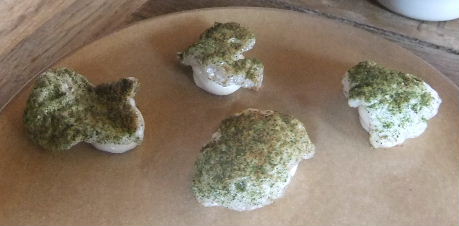
A bit more decadent.
Caramelized Onion Beignet.

Jerusalem artichoke on cheese biscuit.

Nice flavors.
Beetroot, yoghurt.

Richer.
Cockles with wood sorrel.

There were four fresh cockles under the wood sorrel leaves.
In the corner of the dining room were four loaves of rustic bread the size of rugby balls. A server sliced them and brought thick pieces to us with butter, salt and porkfat with bacon.

In de Wulf’s wine list is surprisingly insubstantial. I guess that there have been other investment priorities. We ordered a bottle of 2008 Henri Boillot Puligny-Montrachet; it was disappointingly thin. We also ordered a bottle of 2005 Tardieu Laurent Châteauneuf du Pape; like all Tardieu Laurent wines, it was reliably good, without being very good.
Now the main menu, “land & sea,” began.
Seabass, razor clams, celery and rucola.

The seabass was barely cooked. It was served on celery juice with a buttermilk granità.
Bouchot mussel, poached in wheysauce, mustardgrains

The small poached mussels are under the greenery.
Asparagus, goatcheese from Uxem, wood sorrel

The white asparagus stalk was dressed with brown butter and cheese whey. The cheese is from the nearby town of Uxem, over the border in France.
Brill, swiss chard

Brill, or barbue in French, is like a small turbot and has its very good flavor.
An extra course of squid, squid ink and ashes
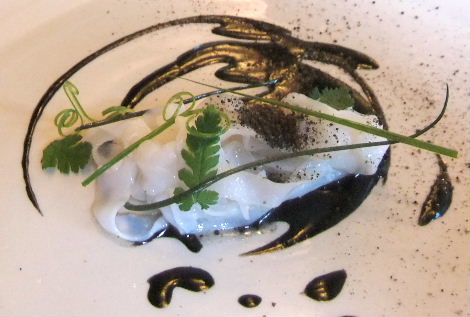
The fresh squid flavor was subtle and concentrated at the same time. Exquisite.
“Oosterschelde” lobster, radish, horseradish

This seasonal local lobster has a sweet flavor which was nicely contrasted with the radishes and horseradish.
Charred cucumber homecured bacon, chervil, “Pas de rouge” cheese
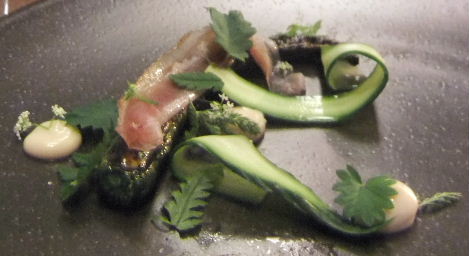
“Pas de rouge” is a strong Belgian cow’s milk cheese. It went nicely with the charred and raw cucumber and the mild bacon strip.
Roasted green asparagus and leeks, “Hommelbier”, poached egg

Asparagus in Belgium usually means white asparagus, but here local green ones are cooked with local hops and beer.
Beef “West-Vlaams rood” dry aged for 5 weeks, ramsons, onion

“West Flemish Red” is a local breed for both milk and meat. I would guess that this was just grass fed. After aging it was tender with an excellent flavor. The seasonal wild garlic garnish went well.
The chef presented a special extra course to us: Pigeon aged in smoked hay for a week, then smoked and aged two weeks more in hay before being lightly roasted.


The flavor was sublime.
The desserts began
Goatyoghurt, malt


The flaky white pastry was served with a special strawberry just picked across the street.
Beetroot, rosehip, chocolat

A medley of slightly sweet and sour flavors.
Cucumber, green strawberries, sorrel
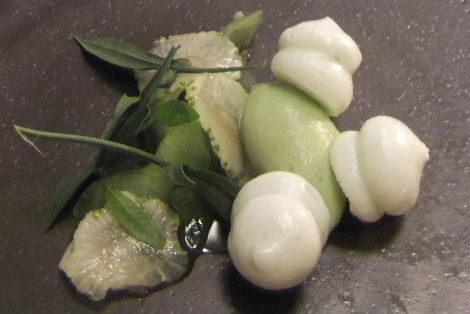
The green strawberry sorbet brought this all together.
Finally, there were mignardises.
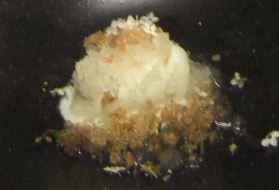


I didn’t note what they were, but we enjoyed them. We were feeling very mellow, took a walk outside and went on upstairs to our room.
In the morning we came down to the charming old-fashioned breakfast room, where the hostess prepared eggs and bacon to go with the substantial buffet.


On the buffet were breads, jams, charcuterie, smoked salmon and garden fresh strawberries.




From our table we could look across the emerging vegetable garden in raised beds outside the window up the hill where the farmer was picking something, maybe asparagus; I think he must have been up early for the strawberries.

After breakfast we walked in the gardens behind the restaurant.


We said farewell to the charming and talented chef and drove around the countryside before joining the autoroute south to Paris.
Our meal was exquisite, enhanced by the bucolic ambience and the welcoming staff. Kobe has his own style, certainly influenced by his two years at Oud Sluis, but also by popular locavore trends. His ingredients are mostly local, seasonal and top quality. He uses his inventiveness to bring out the best of their flavors. Bravissimo.
May 30, 2011 at 1:11 pm
Excellent report. I look forward to my return in July.
May 31, 2011 at 10:40 am
WOW! What an incredible place and menu. Makes me so hungry; want to pack my bags and go now!
August 7, 2011 at 2:48 am
Food looks so clean and real. Loved the elegance of the dishes. Wish I was there. Thanks for sharing.
September 29, 2011 at 2:39 am
I just ate here last week – as you could imagine, i found it near-perfect – such a perfect place
September 29, 2011 at 2:41 am
oh, and Linda (a veteran of quite a few places brought on to consult) assured me the wine list would get much better
September 29, 2011 at 12:48 pm
We had an excellent dinner at In de Wulf in July, our second time there. I thought Linda’s wine pairing added above and beyond excellence to the experience.
November 14, 2011 at 12:49 pm
[…] In de Wulf (Heuvelland, Belgium) by Epicures In the middle of acres of farmland, un-mappable by GPS, In de Wulf sits unassumingly. There are nearby fields where cooks forage for herbs and an on-grounds garden with chickens. Amidst this stunning setting, Kobe Desramaults crafts a magical intimate meal that is nuanced, light, and deceptively simple. There is a clear noma influence but the food is not as overtly modern or bountiful; it is a more austere and rustic cousin, but no less impactful. This was one of my favorite meals this year – one of those very special places in the world. (And don’t miss breakfast!) […]
January 30, 2012 at 11:54 am
[…] for one day and night to the border is a rewarding move. The food looks more composed than in years past; hopefully this is evidence of Chef Kobe Desramaults maturing and refining. How much more refined […]